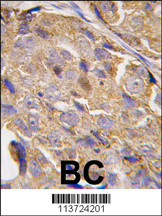Rabbit anti-EIF4B(S422) Polyclonal Antibody描述别名宿主特异性反应种属应用分子量类型同种型储存/保存方法存储溶液研究领域背景说明UniProt参考文献
| 概述 | |
| 描述 |
Peptide Affinity Purified Rabbit Polyclonal Antibody (Pab)
|
| 别名 |
EIF4B抗体;Eukaryotic translation initiation factor 4B; eIF-4B; EIF4B
|
| 宿主 |
Rabbit
|
| 特异性 |
This EIF4B antibody is generated from rabbits immunized with a KLH conjugated synthetic peptide between 400-429 amino acids from human EIF4B.
|
| 反应种属 |
Human
|
| 应用 |
WB~~1:1000
IHC-P~~1:10~50 |
| 分子量 |
Predicted molecular weight: 69kD
Disclaimer note: The observed molecular weight of the protein may vary from the listed predicted molecular weight due to post translational modifications, post translation cleavages, relative charges, and other experimental factors. |
| 性能 | |
| 类型 |
Polyclonal Antibody
|
| 同种型 |
Rabbit Ig
|
| 储存/保存方法 |
Maintain refrigerated at 2-8°C for up to 2 weeks. For long term storage store at -20°C in small aliquots to prevent freeze-thaw cycles.
|
| 存储溶液 |
Purified polyclonal antibody supplied in PBS with 0.09% (W/V) sodium azide. This antibody is purified through a protein A column, followed by peptide affinity purification.
|
| 研究领域 |
Others
|
| 靶标 | |
| 背景说明 |
Required for the binding of mRNA to ribosomes. Functions in close association with EIF4-F and EIF4-A. Binds near the 5′- terminal cap of mRNA in presence of EIF-4F and ATP. Promotes the ATPase activity and the ATP-dependent RNA unwinding activity of both EIF4-A and EIF4-F.
|
| UniProt |
P23588
|
| 参考文献 | |
| 参考文献 |
Doepker, R.C., et al., J. Virol. 78(9):4684-4699 (2004).
Fleming, K., et al., Biochemistry 42(30):8966-8975 (2003). Milburn, S.C., et al., EMBO J. 9(9):2783-2790 (1990). |
实验结果图

Western blot analysis of EIF4B (arrow) using rabbit polyclonal EIF4B Antibody (S422) (RB13724). 293 cell lysates (2 ug/lane) either nontransfected (Lane 1) or transiently transfected with the EIF4B gene (Lane 2) (Origene Technologies).

Formalin-fixed and paraffin-embedded human breast carcinoma tissue reacted with EIF4B-S422, which was peroxidase-conjugated to the secondary antibody, followed by DAB staining. This data demonstrates the use of this antibody for immunohistochemistry; clinical relevance has not been evaluated.
